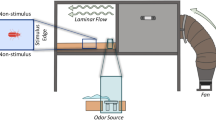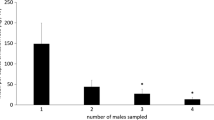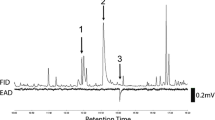Abstract
Intraspecific attraction depends both on the cues provided by the attracting individual and the response of the attracted individual. These attracting cues are related not only to current conditions, but also are a reflection of individual and population life history. These relationships were examined by placing red flour beetle, Tribolium castaneum (Herbst.), adults in flasks at increasing densities and monitoring the changes in volatile chemical emission over time. Only certain chemicals were quantified: methyl benzoquinone, ethyl benzoquinone and 4,8-dimethyldecanal, all of which are known to impact the biology of T. castaneum. The flasks were used as sources for both quantification of the chemicals and for bioassays. Additional bioassays were conducted with synthetic 4,8-dimethyldecanal, a known aggregation pheromone component, to evaluate attraction with respect to population density. Tribolium castaneum density affected both the release of volatile chemicals and the responses of conspecifics to those chemicals. The results indicated that while there were important effects of beetle density on chemical emission and response, none of the chemicals evaluated emerged as promising synergists to the current aggregation pheromone 4,8-dimethyldecanal. The benzoquinones released in response to stress and density acted as anti-aggregation pheromones along with their accepted defensive function.



Similar content being viewed by others
References
DINGLE, H. 1972. Migration strategies of insects. Science 175:1327–1335.
DUEHL, A. J., ARBOGAST, R. T., and TEAL, P. E. 2011. Age and sex related responsiveness of Tribolium castaneum (Coleoptera: Tenebrionidae) in novel behavioral bioassays. Environ. Entomol. 40:82–87.
FAUSTINI, D. L., and BURKHOLDER, W. E. 1987. Quinone-aggregation pheromone interaction in the red flour beetle. Anim. Behav. 35:601–603.
Ghent, A. W. 1963. Studies of behavior of Tribolium flour beetles 1. contrasting responses of T. castaneum and T. confusum to fresh and conditioned flours. Ecology 44:269–283.
Hodjat, S. H. 1970. Effects of crowding on colour, size and larval activity of Spodoptera littoralis (Lepidoptera: Noctuidae). Entomol. Exp. Appl. 13:97–106.
Keville, R. and Kannowski, P. B. 1975. Sexual excitation by the pheromones of the confused flour beetle. J. Insect Physiol. 21:81–84.
Markarian, H., Florentine, G. J., and Pratt, J. J. 1978. Quninone production of some species of Tribolium. J. Insect Physiol. 24:785–790.
Mondal, K. A. M. S. H. 1990. Effect of synthetic quinone and pheromone on Tribolium castaneum. Ann. Entomol. 8:19–21.
Mondal, K. A. M. S. H. 1985. Response of T. castaneum larvae to aggregation pheromone and quinones produced by adult conspecifics. Int. Pest Control 27:64–66.
O’Ceallachain, D. P., and Ryan, M. F. 1977. Production and perception of pheromones by beetle Tribolium confusum. J. Insect Physiol. 23:1303–1309.
Park, T. 1948. Interspecies competition in populations of Tribolium confusum Duval and Trilobium castaneum Herbst. Ecol. Monogr. 18:265–307.
Park, T. 1962. Beetles, competition, and populations: an intricate ecological phenomenon is brought into the laboratory and studied as an experimental model. Science 138:1369–1375.
Roth, L .M., and Howland, R. B. 1941. Studies on the gaseous secretion of Tribolium confusum Duval. I. Abnormalities produced in Tribolium confusum Duval by a secretion given off by the adults. Ann. Entomol. Soc. Am. 34:151–175.
Ryan, M. F., and O’Ceallachain, D. P. 1976. Aggregation and sex pheromones in beetle Tribolium confusum. J. Insect Physiol. 22:1501–1503.
Sokoloff, A. 1974. The Biology of Tribolium: With Special Emphasis on Genetic Aspects. Oxford University Press, Oxford, 609 p.
Suzuki, T. 1980. 4,8-Dimethyldecanal - the aggregation pheromone of the flour beetles, Tribolium castaneum and Tribolium confusum (Coleoptera, Tenebrionidae). Agric. Biol. Chem. 44:2519–2520.
Suzuki, T., Kozaki, R., Sugawara, R., and Mori, K. 1984. Biological activities of the analogs of the aggregation pheromone of Tribolium castaneum (Coleoptera: Tenebrionidae). Appl. Ent. Zool. 19:15–20.
Thatcher, R. C., Searcy, J. L., Coster, J. E., and Hertel, G. D. 1980. The Southern Pine Beetle. USDA, Expanded Southern Pine Beetle Research and Application Program, Forest Service, Science and Education Administration Technical Bulletin 1631, Pineville, LA, 265 p.
Unruh, L. M., Xu, R. D., and Kramer, K. J. 1998. Benzoquinone levels as a function of age and gender of the red flour beetle, Tribolium castaneum. Insect Biochem. Molec. Biol. 28:969–977.
VERHEGGEN, F., RYNE, C., OLSSON, P. O., ARNAUD, L., LOGNAY, G., HÖGBERG, H. E., PERSSON, D., HAUBRUGE, E., and LÖFSTEDT, C. 2007. Electrophysiological and behavioral activity of secondary metabolites in the confused flour beetle, Tribolium confusum. J. Chem. Ecol. 33:525–539.
VON ENDT, D. W., and WHEELER, J. W. 1971. 1-Pentadecene production in Tribolium confusum. Science 172:60–61.
WIRTZ, R. A., TAYLOR, S. L., and SEMEY, H. G. 1978. Concentrations of substituted p-benzoquinones and 1-pentadecene in the flour beetles Tribolium confusum Duval and Tribolium castaneum Herbst. Comp. Biochem. Physiol. 61B:25–28.
WRIGHT, G. A. 2009. Bee pheromones: signal or agent of manipulation? Curr. Biol. 19:R547–R548.
ZIEGLER, J. R. 1976. Evolution of migration response - emigration by Tribolium and the influence of age. Evolution 30:579–592.
Acknowledgments
The authors thank Curtis Murphy for his technical assistance and Dr. Tom Phillips and Dr. Paul Kendra for reviews.
Author information
Authors and Affiliations
Corresponding author
Rights and permissions
About this article
Cite this article
Duehl, A.J., Arbogast, R.T. & Teal, P.E.A. Density-Related Volatile Emissions and Responses in the Red Flour Beetle, Tribolium castaneum . J Chem Ecol 37, 525–532 (2011). https://doi.org/10.1007/s10886-011-9942-3
Received:
Revised:
Accepted:
Published:
Issue Date:
DOI: https://doi.org/10.1007/s10886-011-9942-3




